Effects of Sintering Temperature and Yttria Content on Microstructure, Phase Balance, Fracture Surface Morphology, and Strength of Yttria-Stabilized Zirconia
Abstract
1. Introduction
2. Materials and Methods
3. Results and Discussion
3.1. Characterization of Microstructure
- The average size of pores decreased by 30% in the 3YSZ ceramic; however, it increased by 55% in 6YSZ material (Table 1);
- The average grain size decreased in the 3YSZ ceramic, but no significant variation was observed in the 6YSZ one (Table 1);
- The 6YSZ ceramic sintered at 1450 °C exhibited finer microstructure in terms of the area fractions for the grain size parameter, compared to the 3YSZ ceramic;
- Grain size distributions should always be considered for accurate characterization of microstructure evolution in YSZ ceramics, instead of the average grain size parameter.
3.2. Chemical and Phase Compositions
- For the 3YSZ ceramic, a slow decrease in the tetragonal ZrO2 phase percentage and a steeper increase in the c-ZrO2 phase fraction occurred; a comparatively high fraction of the t-ZrO2 phase (above 59%) is characteristic for this material;
- For the 6YSZ ceramic, a steeper decrease in the tetragonal ZrO2 phase percentage and a slow increase in the c-ZrO2 phase fraction occurred; a comparatively high yttria percentage provides better stabilization of the c-ZrO2 phase in the studied temperature range; a higher sintering temperature facilitates cubic to tetragonal and monoclinic zirconia phase transitions.
3.3. Strength and Analysis of Fracture Surface
- For the 3YSZ ceramic, the strength is almost linearly related to the t-ZrO2 phase fraction;
- For the 6YSZ ceramic, there is no linear relationship between the strength of the material and phase fractions, as the fractions of both the cubic and monoclinic ZrO2 phases are quite high.
- The average size of fracture voids decreased by 67% in the 3YSZ ceramic; however, it increased by 33% in the 6YSZ material (Table 1);
- The observed variations in fracture void size distributions does not fully align with the trend for the average void size. Therefore, the size distributions should always be used for the characterization of microstructure evolution in YSZ ceramics, instead of the average void size parameter.
- The average size of cleavage facets (corresponding to the fracture by the transgranular micromechanism) decreased by 11% in 3YSZ ceramic; however, it increased by 21% in the 6YSZ material (Table 1);
- Cleavage area decreased by 8.5 times in the 3YSZ ceramic; however, it increased by 44% in the 6YSZ material;
- No unambiguous variations of the fractions of cleavage facet distribution were found in the 3YSZ and 6YSZ ceramics with a decrease in sintering temperature from 1550 through 1500 to 1450 °C.
- The most distinct differences for the pore number density and area fraction in the 3YSZ ceramic (both are increasing by a similar value of 1.54 = 0.0724/0.0471 and 1.54 = 4.0/2.6 times) were found with a decrease in sintering temperature from 1500 to 1450 °C. In the 6YSZ ceramic, these parameters varied more (increased by 0.0516/0.02 = 2.58 and 2.4/0.5 = 4.8 times, respectively) with a decrease in sintering temperature from 1550 to 1500 °C (Table 1);
- The pore number density and area fraction of the 3YSZ ceramic sintered at a temperature of 1550 °C are 0.0328/0.02 = 1.64 and 2.9/0.5 = 5.8 times higher, respectively, than those of the 6YSZ ceramic sintered at the same temperature (Table 1);
- With a decrease in sintering temperature from 1550 to 1450 °C, for the 3YSZ ceramic the area fractions of 0.3–0.6 μm and 0.6–0.9 μm grains increased from 4 to 21.5% and from 18 to 59%, respectively; untypically high area fractions (up to 15%) were observed for large grains in the 3YSZ ceramic, namely 2.4–2.7 μm and >2.7 μm grain sizes in the case of sintering temperature of 1550 °C (Figure 4a);
- With a decrease in sintering temperature from 1550 to 1450 °C, for the 6YSZ ceramic, the area fraction of 0.3–0.6 μm grains (the smallest grains, Figure 4b) increased from 24 to 37%; this material exhibited finer microstructure compared to other conditions; for 6YSZ ceramics sintered at 1500 °C and 1450 °C, increased area fractions were revealed for larger grains, >2.4 μm and >1.5 μm grain sizes, respectively;
- It was revealed for the 3YSZ ceramic sintered at 1500 °C (Figure 10a) that the total percentage of relatively small cleavage facets (2–10 µm2) exceeds 90%, whereas this of relatively large cleavage facets (>10 µm2) is less than 10%; with both the increase in the sintering temperature to 1550 °C and decrease to 1450 °C, shifts in the fractions of cleavage facets towards large values are observed; fracture along boundaries of separate clusters occurred in the 3YSZ ceramic sintered at 1450 °C, and no recrystallized zirconia grain was identified; thus, the cleavage facets identified for this material condition cannot be associated with “classic” transgranular fracture;
- A gradual decrease in fractions of cleavage facets (from 31.5% to 16%) in the size range from 2 to 10 µm was observed in the 6YSZ ceramic sintered at 1550 °C, and a small fraction (about 6%) was found for larger cleavage facets (Figure 10b); the total fraction of large cleavage facets of >10 µm2 was much higher (from 20% to about 29%) for sintering temperatures of 1450 °C and 1500 °C than for 1550 °C;
- The above-mentioned differences in the void size distribution shapes may be related to the complex nature of the void formation, as some voids could grow from pre-existing pores and others might have formed in the high-density parts of the volume. This should be taken into account when characterizing the fracture evolution based on the fracture void imaging.
3.4. Technology Optimization
4. Conclusions
- For the 3YSZ ceramic, with an increase in sintering temperature from 1450 to 1550 °C, the porosity decreased (in particular, the pore number density decreased by 2.2 times and their area fraction by 1.4 times), and the number density of fracture voids decreased by 3.6 times. However, at 1550 °C, high area fractions (up to 15%) of coarse grains in the >2.4 μm size range were generated, which was consistent with an increased cleavage facet size. After sintering at the intermediate temperature of 1500 °C, the total percentage of relatively small cleavage facets (from 2 to 10 µm2) reached 90%, the cleavage fracture area was reasonably low (13%), and the flexural strength was high (800 MPa). This resulted from an optimum phases balance consisting of 60% m-ZrO2 and near 20% of each t-ZrO2 and c-ZrO2. Therefore, we propose sintering at 1500 °C for 2 h as a promising technology mode for the 3YSZ ceramic.
- For the 6YSZ ceramic, with an increase in sintering temperature from 1450 to 1550 °C the porosity decreased (in particular, the pore number density decreased by two times and their area fraction decreased by five times), the number density of fracture voids decreased by 2.4 times, the total percentage of relatively small cleavage facets (from 2 to 10 µm2) reached 96%, and the cleavage area decreased to a minor value of 9%. However, the temperature of 1550 °C resulted in a lower fraction of coarse grains (>2.1 μm), probably the m-ZrO2 phase, and a significantly increased the fraction of medium t-ZrO2 grains (0.9–1.5 μm), as compared to 1450 °C for which a high fraction of small t-ZrO2 grains (0.3–0.6 μm) and a quite high fraction of coarse m-ZrO2 grains (1.5–2.4 μm) was found. Therefore, an increase in sintering temperature of the 6YSZ ceramic above 1450 °C did not produce a substantial improvement in strength. This could be explained by a stronger stabilization of the crystal structure with an increased Y2O3 content at 1450 °C leading to an “optimum” phase balance with ~50% m-ZrO2, 35% t-ZrO2, and 15% c-ZrO2.
- 3YSZ sintered at 1550 °C showed about 17% higher strength than 6YSZ sintered at 1450 °C. Thus, lower concentrations of Y2O3 might be positively considered from the mechanical properties point of view. However, a higher cost of energy for sintering at higher temperatures may facilitate adoption of materials with a higher Y2O3 content processed at lower temperatures. Due to the comparatively high strength, the investigated samples can find potential practical applications in manufacturing prostheses and dental implants.
Author Contributions
Funding
Institutional Review Board Statement
Informed Consent Statement
Data Availability Statement
Acknowledgments
Conflicts of Interest
References
- Chevalier, J.; Gremillard, L.; Virkar, A.V.; Clarke, D.R. The tetragonal-monoclinic transformation in zirconia: Lessons learned and future trends. J. Am. Ceram. Soc. 2009, 92, 1901–1920. [Google Scholar] [CrossRef]
- Piconi, C.; Sprio, S. Zirconia implants: Is there a future? Curr. Oral Health Rep. 2018, 5, 186–193. [Google Scholar] [CrossRef]
- Jiang, S.; Huang, X.; He, Z.; Buyers, A. Phase transformation and lattice parameter changes of non-trivalent rare earth-doped YSZ as a function of temperature. J. Mater. Eng. Perform. 2018, 27, 2263–2270. [Google Scholar] [CrossRef]
- Schaedler, T.A.; Leckie, R.M.; Kramer, S.; Evans, A.G.; Levi, C.G. Toughening of nontransformable t’-YSZ by addition of titania. J. Am. Ceram. Soc. 2007, 90, 3896–3901. [Google Scholar] [CrossRef]
- Chabak, Y.G.; Fedun, V.I.; Shimizu, K.; Efremenko, V.G.; Zurnadzhy, V.I. Phase-structural composition of coating obtained by pulsed plasma treatment using eroded cathode of T1 high speed steel. Probl. At. Sci. Technol. Ser. Plasma Electron. N. Accel. Methods 2016, 104, 100–106. [Google Scholar]
- Zhao, M.; Pan, W.; Wan, C.; Qu, Z.; Li, Z.; Yang, J. Defect engineering in development of low thermal conductivity materials: A review. J. Eur. Ceram. Soc. 2017, 37, 1–13. [Google Scholar] [CrossRef]
- Podhurska, V.; Vasyliv, B.; Ostash, O.; Brodnikovskyi, Y.; Vasylyev, O. Influence of treatment temperature on microstructure and properties of YSZ–NiO anode materials. Nanoscale Res. Lett. 2016, 11, 93. [Google Scholar] [CrossRef][Green Version]
- Santos, A.J.; Garcia-Segura, S.; Dosta, S.; Cano, I.G.; Martínez-Huitle, C.A.; Brillas, E. A ceramic electrode of ZrO2-Y2O3 for the generation of oxidant species in anodic oxidation. Assessment of the treatment of Acid Blue 29 dye in sulfate and chloride media. Sep. Purif. Technol. 2019, 228, 115747. [Google Scholar] [CrossRef]
- Chabak, Y.; Efremenko, V.; Zurnadzhy, V.; Puchý, V.; Petryshynets, I.; Efremenko, B.; Fedun, V.; Shimizu, K.; Bogomol, I.; Kulyk, V.; et al. Structural and tribological studies of “(TiC+WC)/Hardened Steel” PMMC coating deposited by air pulsed plasma. Metals 2022, 12, 218. [Google Scholar] [CrossRef]
- Yan, Y.; Ma, Z.; Sun, J.; Bu, M.; Huo, Y.; Wang, Z.; Li, Y.; Hu, N. Surface microstructure-controlled ZrO2 for highly sensitive room-temperature NO2 sensors. Nano Mater. Sci. 2021, 3, 268–275. [Google Scholar] [CrossRef]
- Vasyliv, B.; Milewski, J.; Podhurska, V.; Wejrzanowski, T.; Kulyk, V.; Skibiński, J.; Vira, V.; Szabłowski, Ł.; Szczęśniak, A.; Dybiński, O. Study of the degradation of a fine-grained YSZ–NiO anode material during reduction in hydrogen and reoxidation in air. Appl. Nanosci. 2022, 12, 965–975. [Google Scholar] [CrossRef]
- Vasyliv, B.; Kulyk, V.; Duriagina, Z.; Mierzwinski, D.; Kovbasiuk, T.; Tepla, T. Estimation of the effect of redox treatment on microstructure and tendency to brittle fracture of anode materials of YSZ–NiO(Ni) system. East. Eur. J. Enterp. Technol. 2020, 6, 61–71. [Google Scholar] [CrossRef]
- Vladislavova, L.; Smolorz, T.; Orlovskaya, N.; Lugovy, M.; Reece, M.J.; Köbel, S.; Kopia, A.; Makowska, M.; Graule, T.; Blugan, G. Strength analysis and stress-strain deformation behavior of 3 mol% Y-TZP and 21 wt.% Al2O3-3 mol% Y-TZP. Materials 2021, 14, 3903. [Google Scholar] [CrossRef]
- Li, D.; Liu, Y.; Zhong, Y.; Liu, L.; Adolfsson, E.; Shen, Z. Dense and strong ZrO2 ceramics fully densified in <15 min. Adv. Appl. Ceram. 2019, 118, 23–29. [Google Scholar] [CrossRef]
- Chintapalli, R.; Mestra, A.; Marro, F.G.; Yan, H.; Reece, M.; Anglada, M. Stability of nanocrystalline spark plasma sintered 3Y-TZP. Materials 2010, 3, 800–814. [Google Scholar] [CrossRef]
- Guazzato, M.; Albakry, M.; Ringer, S.P.; Swain, M.V. Strength, fracture toughness and microstructure of a selection of all-ceramic materials. Part II. Zirconia-based dental ceramics. Dent. Mater. 2004, 20, 449–456. [Google Scholar] [CrossRef]
- Zou, J.; Zhong, Y.; Eriksson, M.; Liu, L.; Shen, Z. Tougher zirconia nanoceramics with less yttria. Adv. Appl. Ceram. 2018, 118, 9–15. [Google Scholar] [CrossRef]
- Soubelet, C.G.; Albano, M.P. Differences in microstructure and mechanical properties between Y-TZP and AL2O3-doped Y-TZP/bioglass ceramics. Int. J. Appl. Ceram. Technol. 2021, 18, 2237–2249. [Google Scholar] [CrossRef]
- Stawarczyk, B.; Özcan, M.; Hallmann, L.; Ender, A.; Mehl, A.; Hämmerlet, C.H. The effect of zirconia sintering temperature on flexural strength, grain size, and contrast ratio. Clin. Oral Investig. 2013, 17, 269–274. [Google Scholar] [CrossRef]
- Juntavee, N.; Attashu, S. Effect of different sintering process on flexural strength of translucency monolithic zirconia. J. Clin. Exp. Dent. 2018, 10, e821–e830. [Google Scholar] [CrossRef]
- Chevalier, J. What future for zirconia as a biomaterial? Biomaterials 2006, 27, 535–543. [Google Scholar] [CrossRef]
- Kim, M.-J.; Ahn, J.-S.; Kim, J.-H.; Kim, H.-Y.; Kim, W.-C. Effects of the sintering conditions of dental zirconia ceramics on the grain size and translucency. J. Adv. Prosthodont. 2013, 5, 161–166. [Google Scholar] [CrossRef]
- Gautam, C.; Joyner, J.; Gautam, A.; Rao, J.; Vajtai, R. Zirconia based dental ceramics: Structure, mechanical properties, biocompatibility and applications. Dalton Trans. 2016, 45, 19194–19215. [Google Scholar] [CrossRef]
- Amaral, M.; Cesar, P.F.; Bottino, M.A.; Lohbauer, U.; Valandro, L.F. Fatigue behavior of Y-TZP ceramic after surface treatments. J. Mech. Behav. Biomed. Mater. 2016, 57, 149–156. [Google Scholar] [CrossRef]
- Kumar, A.; Kumar, P.; Dhaliwal, A.S. Structural studies of zirconia and yttria doped zirconia for analysing it phase stabilization criteria. IOP Conf. Ser. Mater. Sci. Eng. 2021, 1033, 012052. [Google Scholar] [CrossRef]
- Gupta, T.K.; Bechtold, J.H.; Kuznicki, R.C.; Cadoff, L.H.; Rossing, B.R. Stabilization of tetragonal phase in polycrystalline zirconia. J. Mater. Sci. 1977, 12, 2421–2426. [Google Scholar] [CrossRef]
- Scott, H.G. Phase relationships in the zirconia–yttria system. J. Mater. Sci. 1975, 10, 1527–1535. [Google Scholar] [CrossRef]
- Chevalier, J.; Deville, S.; Munch, E.; Jullian, R.; Lair, F. Critical effect of cubic phase on aging in 3 mol% yttria-stabilized zirconia ceramics for hip replacement prosthesis. Biomaterials 2004, 25, 5539–5545. [Google Scholar] [CrossRef]
- Deville, S.; Gremillard, L.; Chevalier, J.; Fantozzi, G. A critical comparison of methods for the determination of the aging sensitivity in biomedical grade yttria-stabilized zirconia. J. Biomed. Mater. Res. B Appl. Biomater. 2005, 72B, 239–245. [Google Scholar] [CrossRef]
- Studart, A.R.; Filser, F.; Kocher, P.; Gauckler, L.J. Fatigue of zirconia under cycling loading in water and its implications for the design of dental bridges. Dent. Mater. 2007, 23, 106–114. [Google Scholar] [CrossRef]
- Alfano, M.; Girolamo, G.D.; Pagnotta, L.; Sun, D. Processing, microstructure and mechanical properties of air plasma-sprayed ceria–yttria co-stabilized zirconia coatings. Strain 2010, 46, 409–418. [Google Scholar] [CrossRef]
- Girolamo, G.D.; Blasi, C.; Schioppa, M.; Tapfer, L. Structure and thermal properties of heat treated plasma sprayed ceria–yttria co-stabilized zirconia coatings. Ceram. Int. 2010, 36, 961–968. [Google Scholar] [CrossRef]
- Chen, G.; Ling, Y.; Li, Q.; Zheng, H.; Li, K.; Jiang, Q.; Chen, J.; Omran, M.; Gao, L. Crystal structure and thermomechanical properties of CaO-PSZ ceramics synthesised from fused ZrO2. Ceram. Int. 2020, 46, 15357–15363. [Google Scholar] [CrossRef]
- Chen, G.; Li, Q.; Ling, Y.; Zheng, H.; Chen, J.; Jiang, Q.; Li, K.; Peng, J.; Omran, M.; Gao, L. Phase stability and microstructure morphology of microwave-sintered magnesia-partially stabilised zirconia. Ceram. Int. 2021, 47, 4076–4082. [Google Scholar] [CrossRef]
- Gui, J.; Xie, Z. Phase transformation and slow crack growth study of Y-TZP dental ceramic. Mater. Sci. Eng. A 2016, 676, 531–535. [Google Scholar] [CrossRef]
- Bona, A.D.; Pecho, O.E.; Alessandretti, R. Zirconia as a dental biomaterial. Materials 2015, 8, 4978–4991. [Google Scholar] [CrossRef]
- Romaniv, O.M.; Zalite, I.V.; Simin’Kovych, V.M.; Tkach, O.N.; Vasyliv, B.D. Effect of the concentration of zirconium dioxide on the fracture resistance of Al2O3–ZrO2 ceramics. Mater. Sci. 1996, 31, 588–594. [Google Scholar] [CrossRef]
- Romaniv, O.M.; Vasyliv, B.D. Some features of formation of the structural strength of ceramic materials. Mater. Sci. 1998, 34, 149–161. [Google Scholar] [CrossRef]
- Kulyk, V.V.; Duriagina, Z.A.; Vasyliv, B.D.; Vavrukh, V.I.; Lyutyy, P.Y.; Kovbasiuk, T.M.; Holovchuk, M.Y. Effects of yttria content and sintering temperature on the microstructure and tendency to brittle fracture of yttria-stabilized zirconia. Arch. Mater. Sci. Eng. 2021, 109, 65–79. [Google Scholar] [CrossRef]
- Kulyk, V.; Duriagina, Z.; Vasyliv, B.; Vavrukh, V.; Kovbasiuk, T.; Lyutyy, P.; Vira, V. The effect of sintering temperature on the phase composition, microstructure, and mechanical properties of yttria-stabilized zirconia. Materials 2022, 15, 2707. [Google Scholar] [CrossRef]
- Li, Q.-L.; Jiang, Y.-Y.; Wei, Y.-R.; Swain, M.V.; Yao, M.-F.; Li, D.-S.; Wei, T.; Jian, Y.-T.; Zhao, K.; Wang, X.-D. The influence of yttria content on the microstructure, phase stability and mechanical properties of dental zirconia. Ceram. Int. 2022, 48, 5361–5368. [Google Scholar] [CrossRef]
- Kulyk, V.; Duriagina, Z.; Kostryzhev, A.; Vasyliv, B.; Vavrukh, V.; Marenych, O. The effect of yttria content on microstructure, strength, and fracture behavior of yttria-stabilized zirconia. Materials 2022, 15, 5212. [Google Scholar] [CrossRef]
- Trunec, M.; Castkova, K.; Roupcova, P. Effect of phase structure on sintering behavior of zirconia nanopowders. J. Am. Ceram. Soc. 2013, 96, 3720–3727. [Google Scholar] [CrossRef]
- Duràn, P.; Villegas, M.; Fernàndez, J.F.; Capel, F.; Moure, C. Theoretically dense and nanostructured ceramics by pressureless sintering of nanosized Y-TZP powders. Mater. Sci. Eng. A 1997, 232, 168–176. [Google Scholar] [CrossRef]
- Gere, J.M.; Timoshenko, S.P. Mechanics of Materials, 4th ed.; PWS Publishing Company: Boston, MA, USA, 1997; p. 912. [Google Scholar]
- Nonaka, K.; Teramae, M.; Pezzotti, G. Evaluation of the effect of high-speed sintering on the properties of 5 mol% yttria stabilized dental zirconia sintered bodies. Materials 2022, 15, 5685. [Google Scholar] [CrossRef]
- Wojteczko, K.; Pędzich, Z.; Zientara, D.; Berent, K.; Haberko, K. Phenomena occurring upon the sintering of a mixture of yttria–zirconia nanometric powder and sub-micrometric pure zirconia powder. Materials 2021, 14, 6937. [Google Scholar] [CrossRef]
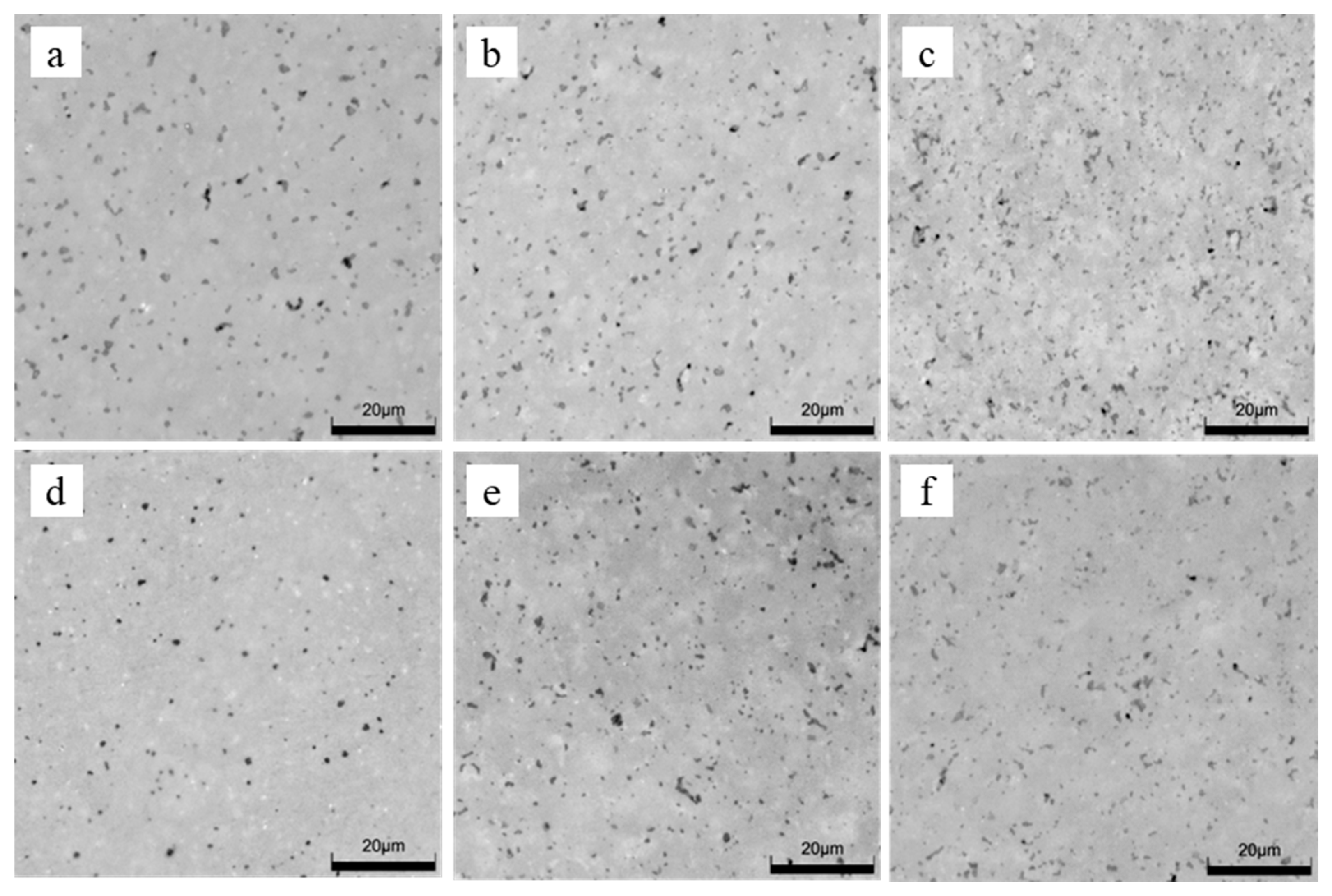


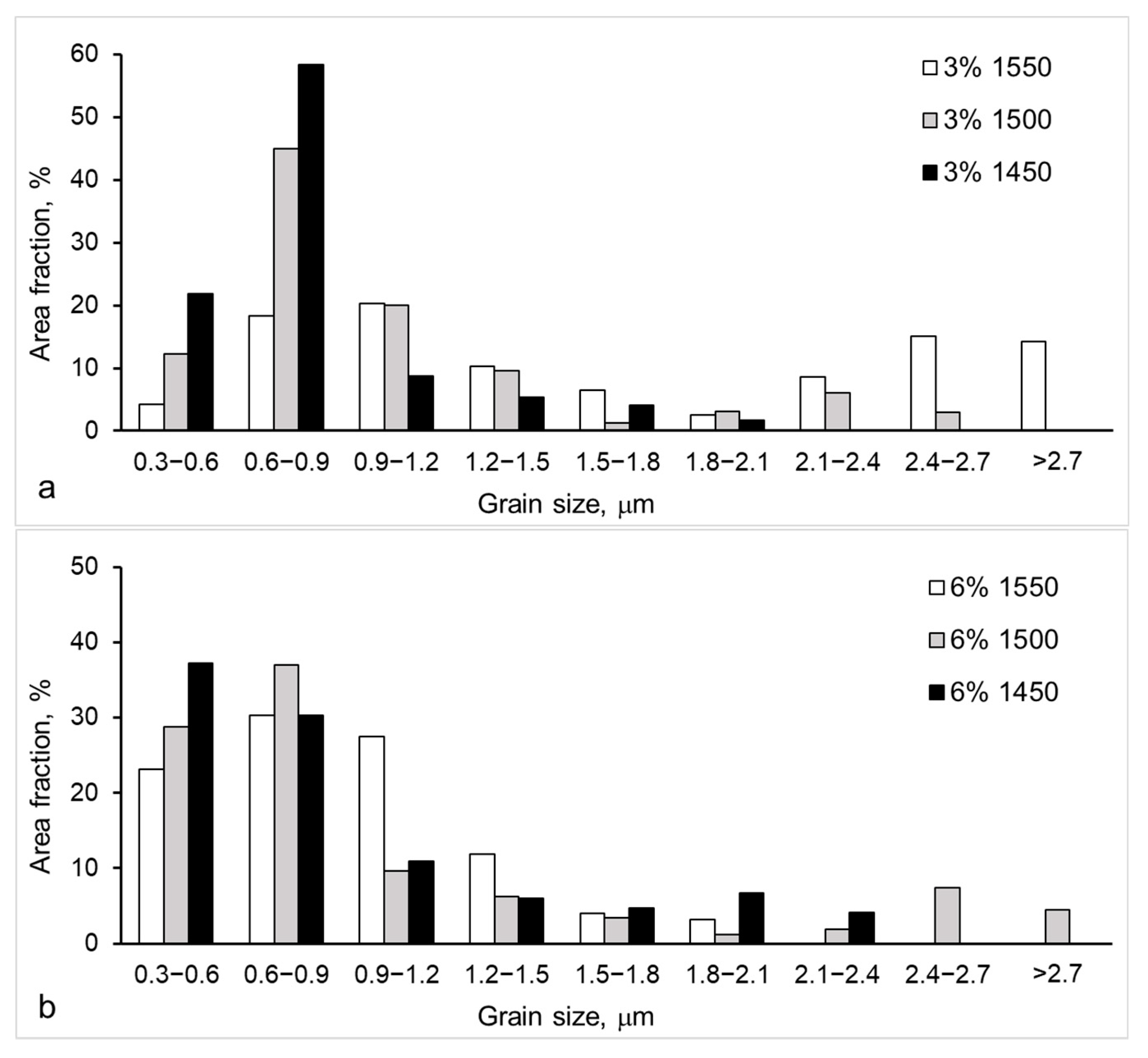
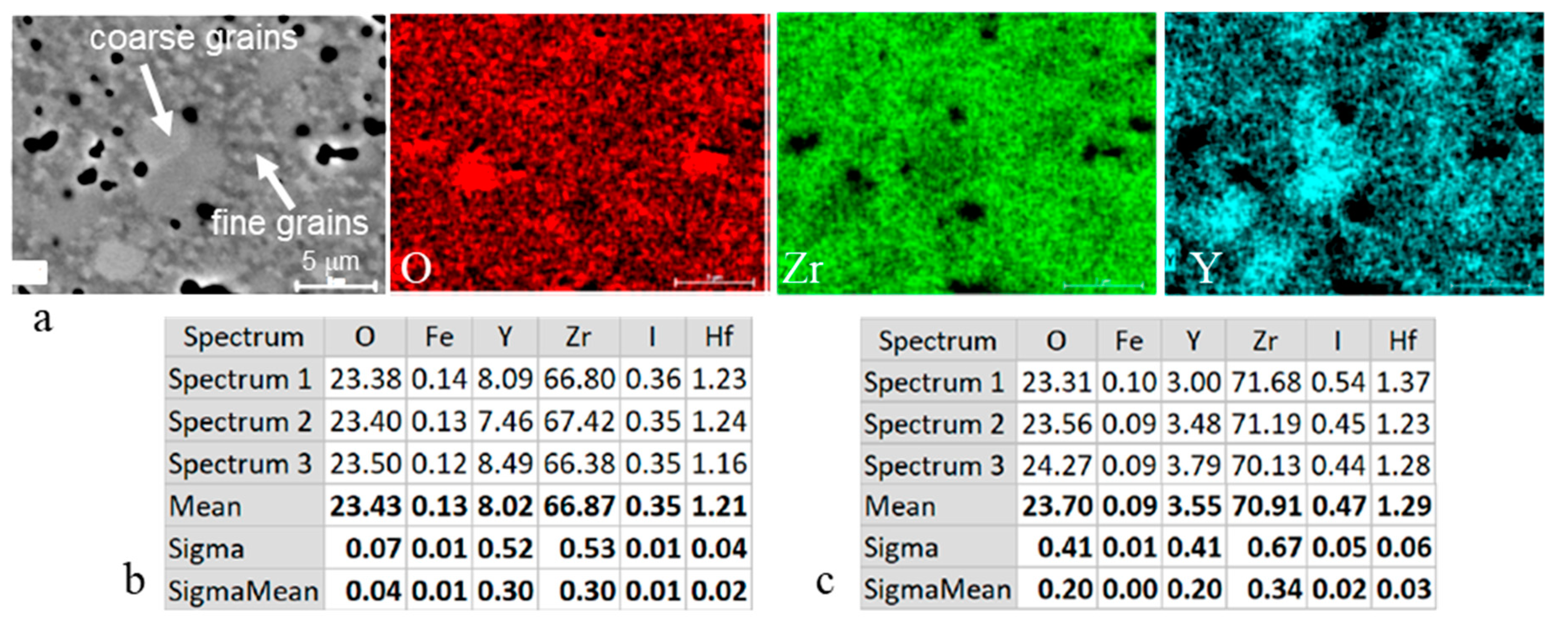
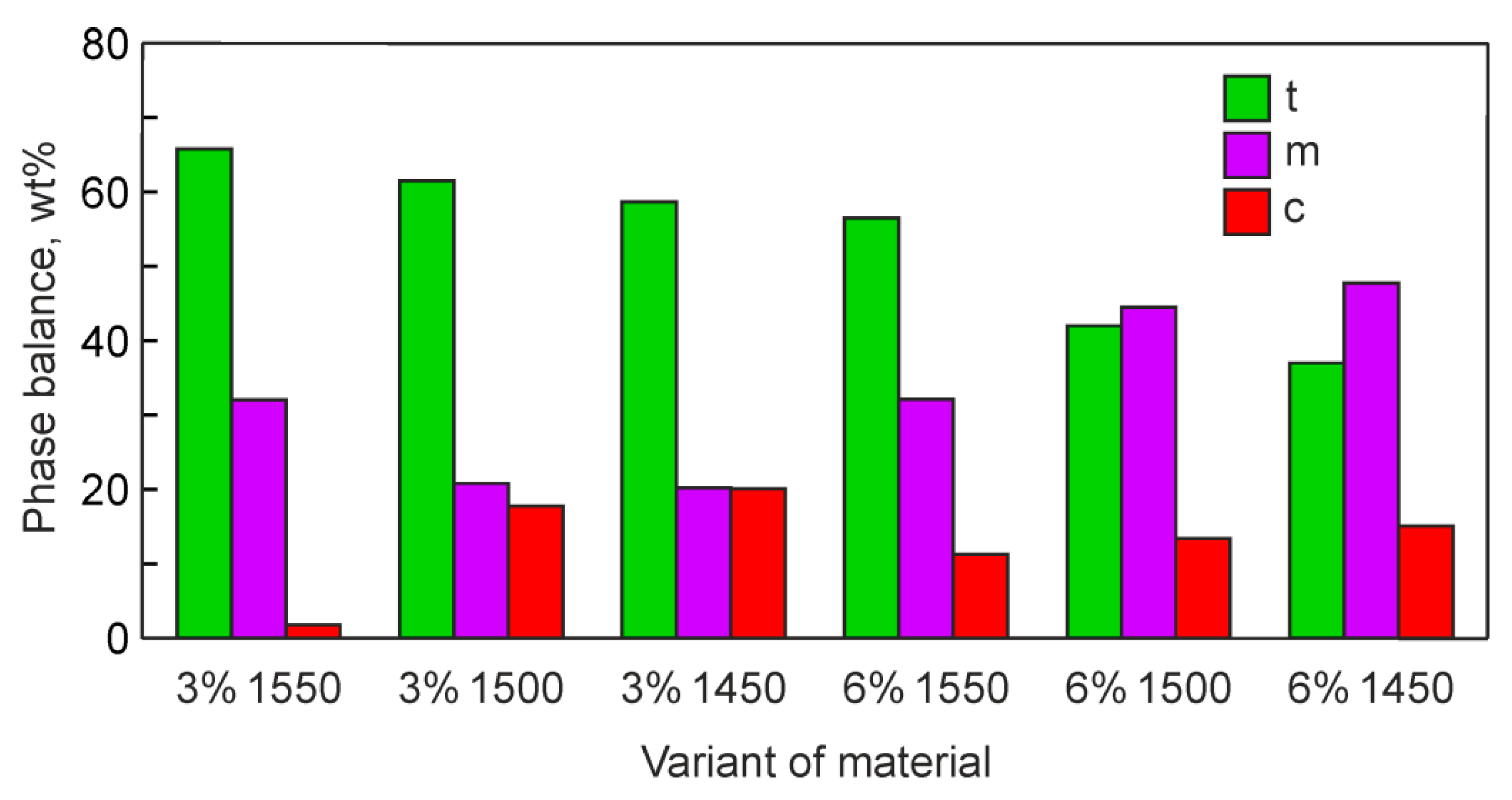
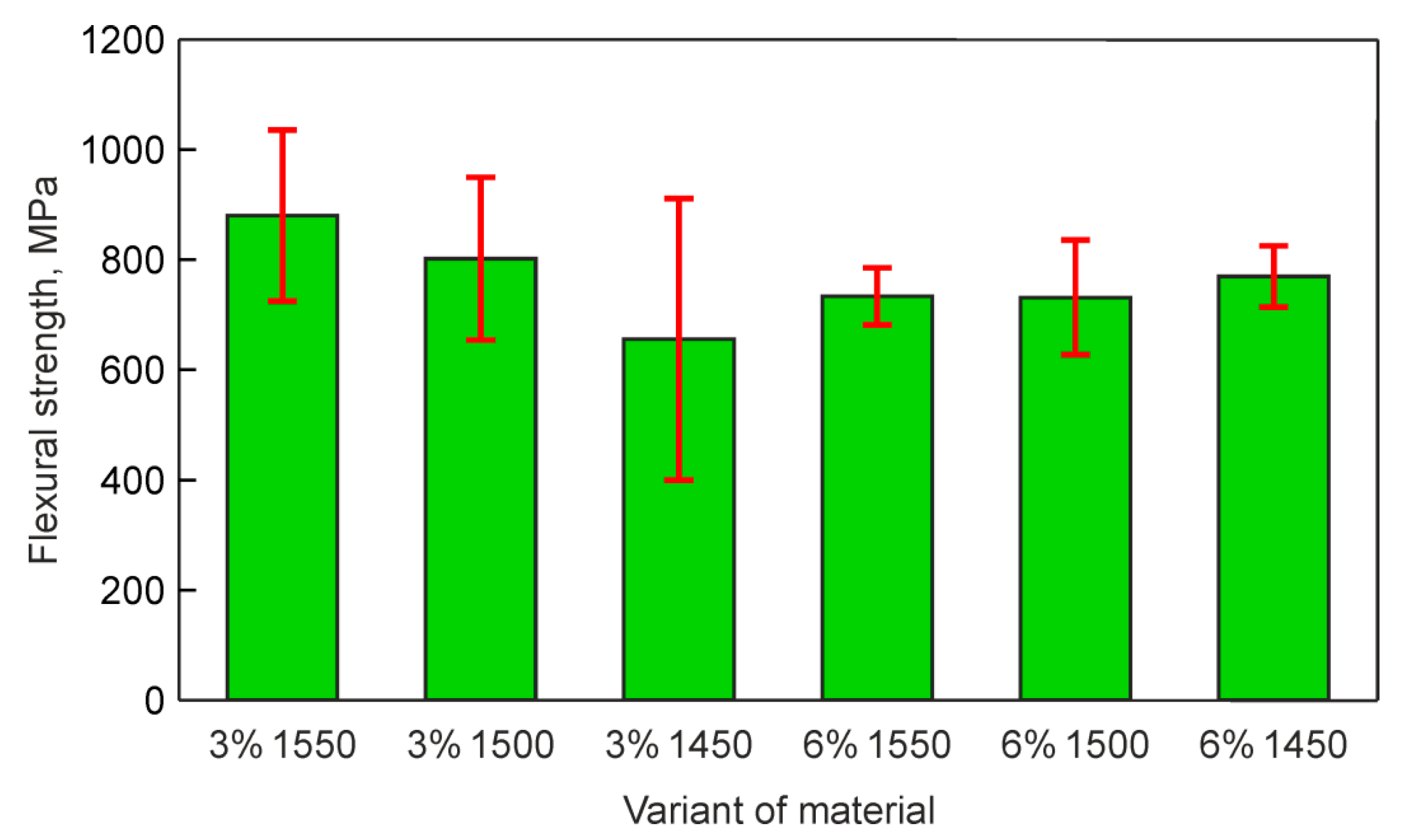
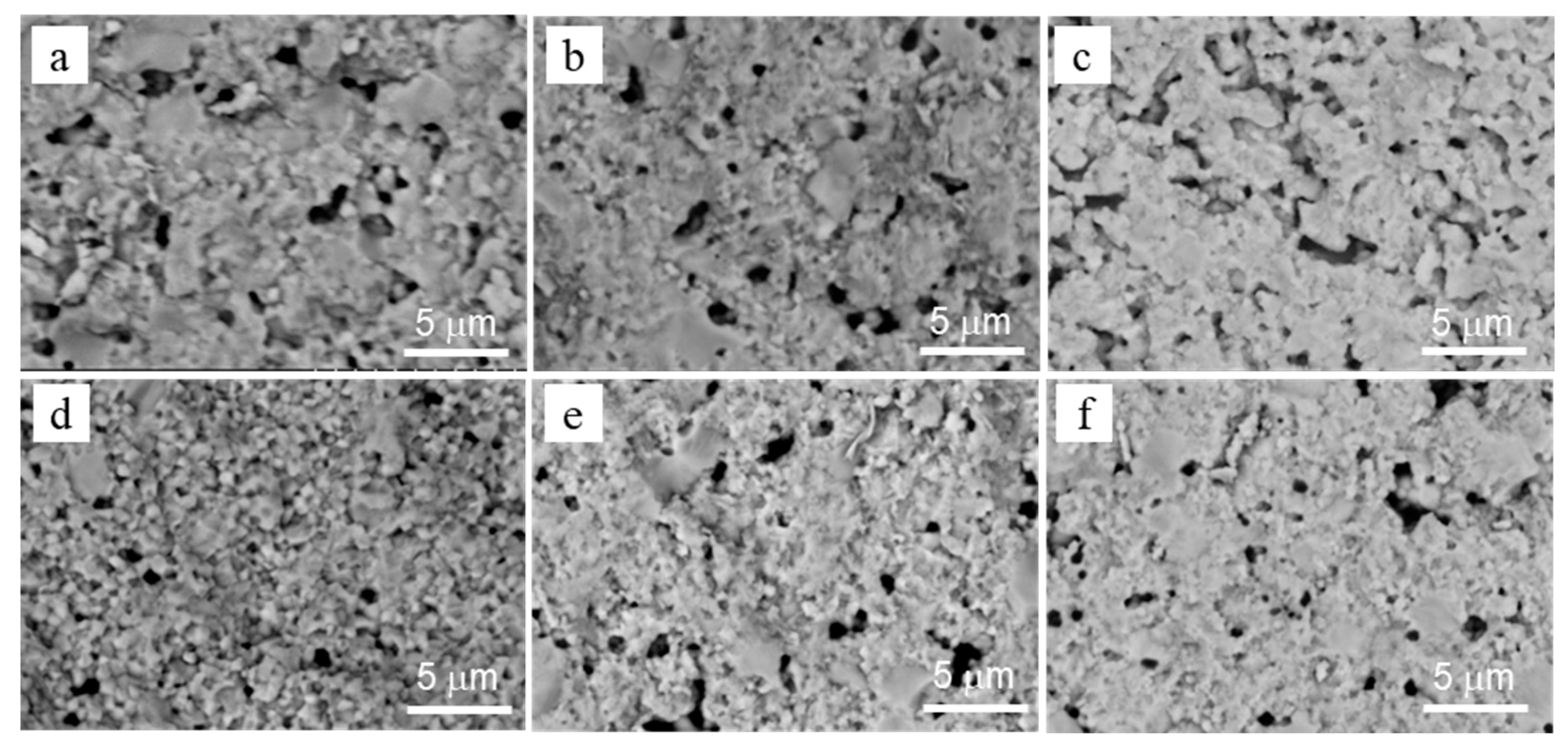

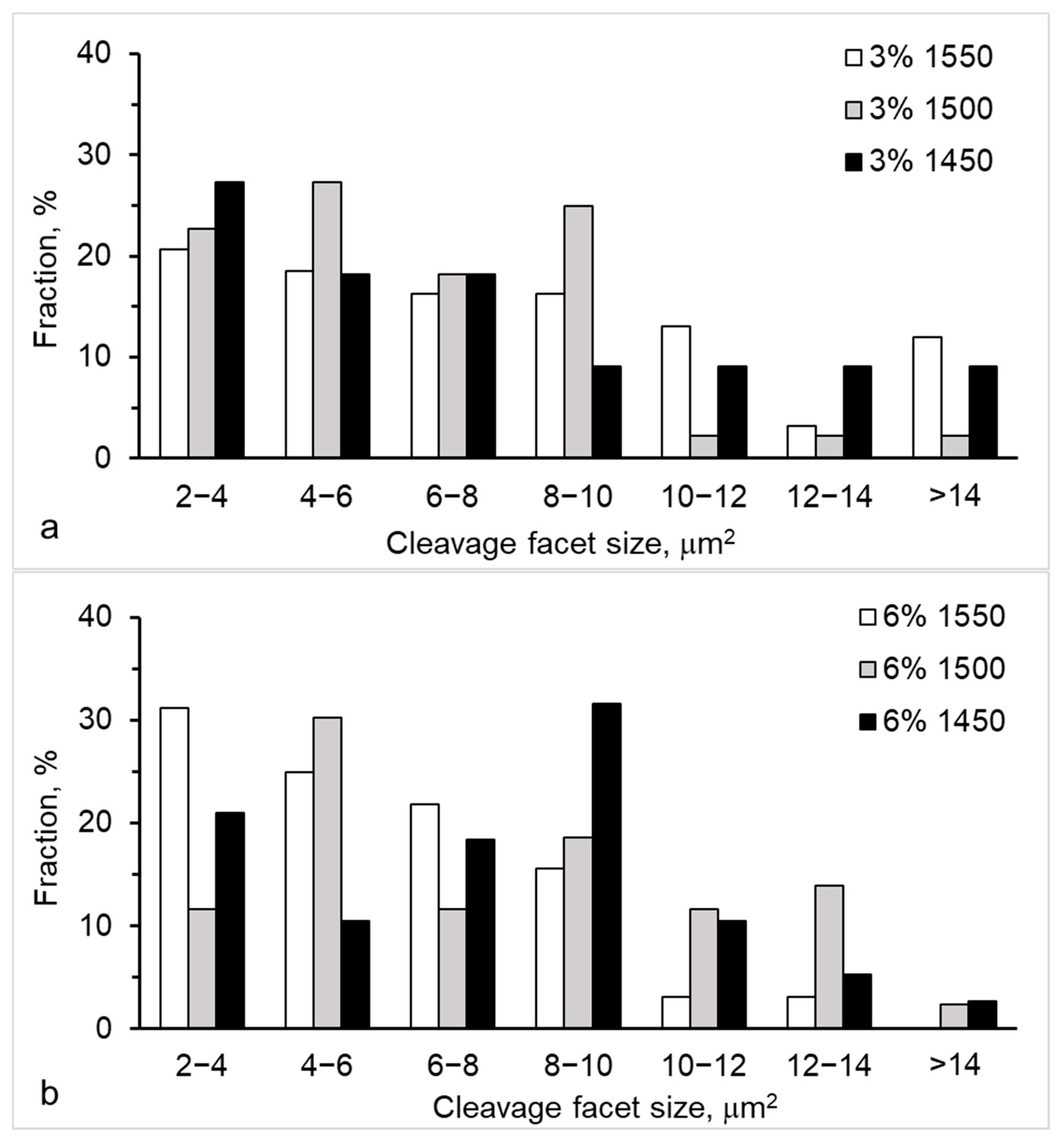
| % Y2O3 | Sintering Temperature, °C | Average Grain Size, µm | Pores | Fracture Voids | Cleavage Facets | |||||
|---|---|---|---|---|---|---|---|---|---|---|
| Average Size, µm | Number Density, µm−2 | Area Fraction, % | Average Size, µm | Number Density, µm−2 | Average Size, µm2 | Number Density, µm−2 | Area Fraction, % | |||
| 3 | 1550 | 1.0 ± 0.5 | 0.9 ± 0.6 | 0.0328 | 2.9 | 0.7 ± 0.4 | 0.039 | 8.0 ± 4.9 | 0.043 | 34 |
| 1500 | 0.7 ± 0.3 | 0.7 ± 0.4 | 0.0471 | 2.6 | 0.5 ± 0.2 | 0.076 | 6.4 ± 3.2 | 0.020 | 13 | |
| 1450 | 0.6 ± 0.2 | 0.7 ± 0.5 | 0.0724 | 4.0 | 0.4 ± 0.2 | 0.142 | 7.2 ± 4.0 | 0.005 | 4 | |
| 6 | 1550 | 0.7 ± 0.3 | 0.5 ± 0.3 | 0.0200 | 0.5 | 0.4 ± 0.1 | 0.030 | 6.1 ± 2.9 | 0.015 | 9 |
| 1500 | 0.6 ± 0.3 | 0.6 ± 0.4 | 0.0516 | 2.4 | 0.5 ± 0.2 | 0.057 | 7.9 ± 4.9 | 0.020 | 16 | |
| 1450 | 0.6 ± 0.3 | 0.8 ± 0.5 | 0.0409 | 2.5 | 0.5 ± 0.3 | 0.071 | 7.4 ± 3.2 | 0.018 | 13 | |
Publisher’s Note: MDPI stays neutral with regard to jurisdictional claims in published maps and institutional affiliations. |
© 2022 by the authors. Licensee MDPI, Basel, Switzerland. This article is an open access article distributed under the terms and conditions of the Creative Commons Attribution (CC BY) license (https://creativecommons.org/licenses/by/4.0/).
Share and Cite
Kulyk, V.; Duriagina, Z.; Kostryzhev, A.; Vasyliv, B.; Marenych, O. Effects of Sintering Temperature and Yttria Content on Microstructure, Phase Balance, Fracture Surface Morphology, and Strength of Yttria-Stabilized Zirconia. Appl. Sci. 2022, 12, 11617. https://doi.org/10.3390/app122211617
Kulyk V, Duriagina Z, Kostryzhev A, Vasyliv B, Marenych O. Effects of Sintering Temperature and Yttria Content on Microstructure, Phase Balance, Fracture Surface Morphology, and Strength of Yttria-Stabilized Zirconia. Applied Sciences. 2022; 12(22):11617. https://doi.org/10.3390/app122211617
Chicago/Turabian StyleKulyk, Volodymyr, Zoia Duriagina, Andrii Kostryzhev, Bogdan Vasyliv, and Olexandra Marenych. 2022. "Effects of Sintering Temperature and Yttria Content on Microstructure, Phase Balance, Fracture Surface Morphology, and Strength of Yttria-Stabilized Zirconia" Applied Sciences 12, no. 22: 11617. https://doi.org/10.3390/app122211617
APA StyleKulyk, V., Duriagina, Z., Kostryzhev, A., Vasyliv, B., & Marenych, O. (2022). Effects of Sintering Temperature and Yttria Content on Microstructure, Phase Balance, Fracture Surface Morphology, and Strength of Yttria-Stabilized Zirconia. Applied Sciences, 12(22), 11617. https://doi.org/10.3390/app122211617








